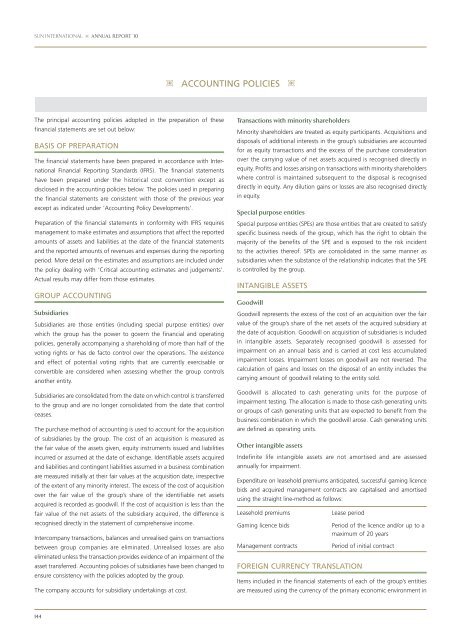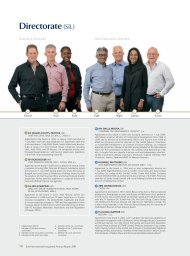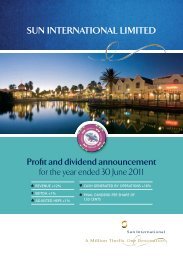PDF 25 MB - Sun International | Investor Centre
PDF 25 MB - Sun International | Investor Centre
PDF 25 MB - Sun International | Investor Centre
You also want an ePaper? Increase the reach of your titles
YUMPU automatically turns print PDFs into web optimized ePapers that Google loves.
SUN INTERNATIONAL ANNUAL REPORT ’10<br />
The principal accounting policies adopted in the preparation of these<br />
financial statements are set out below:<br />
BASIS OF PREPARATION<br />
The financial statements have been prepared in accordance with <strong>International</strong><br />
Financial Reporting Standards (IFRS). The financial statements<br />
have been prepared under the historical cost convention except as<br />
disclosed in the accounting policies below. The policies used in preparing<br />
the financial statements are consistent with those of the previous year<br />
except as indicated under ’Accounting Policy Developments’.<br />
Preparation of the financial statements in conformity with IFRS requires<br />
management to make estimates and assumptions that affect the reported<br />
amounts of assets and liabilities at the date of the financial statements<br />
and the reported amounts of revenues and expenses during the reporting<br />
period. More detail on the estimates and assumptions are included under<br />
the policy dealing with ‘Critical accounting estimates and judgements’.<br />
Actual results may differ from those estimates.<br />
GROUP ACCOUNTING<br />
Subsidiaries<br />
Subsidiaries are those entities (including special purpose entities) over<br />
which the group has the power to govern the financial and operating<br />
policies, generally accompanying a shareholding of more than half of the<br />
voting rights or has de facto control over the operations. The existence<br />
and effect of potential voting rights that are currently exercisable or<br />
convertible are considered when assessing whether the group controls<br />
another entity.<br />
Subsidiaries are consolidated from the date on which control is transferred<br />
to the group and are no longer consolidated from the date that control<br />
ceases.<br />
The purchase method of accounting is used to account for the acquisition<br />
of subsidiaries by the group. The cost of an acquisition is measured as<br />
the fair value of the assets given, equity instruments issued and liabilities<br />
incurred or assumed at the date of exchange. Identifiable assets acquired<br />
and liabilities and contingent liabilities assumed in a business combination<br />
are measured initially at their fair values at the acquisition date, irrespective<br />
of the extent of any minority interest. The excess of the cost of acquisition<br />
over the fair value of the group’s share of the identifiable net assets<br />
acquired is recorded as goodwill. If the cost of acquisition is less than the<br />
fair value of the net assets of the subsidiary acquired, the difference is<br />
recognised directly in the statement of comprehensive income.<br />
Intercompany transactions, balances and unrealised gains on transactions<br />
between group companies are eliminated. Unrealised losses are also<br />
eliminated unless the transaction provides evidence of an impairment of the<br />
asset transferred. Accounting policies of subsidiaries have been changed to<br />
ensure consistency with the policies adopted by the group.<br />
The company accounts for subsidiary undertakings at cost.<br />
144<br />
ACCOUNTING POLICIES<br />
Transactions with minority shareholders<br />
Minority shareholders are treated as equity participants. Acquisitions and<br />
disposals of additional interests in the group’s subsidiaries are accounted<br />
for as equity transactions and the excess of the purchase consideration<br />
over the carrying value of net assets acquired is recognised directly in<br />
equity. Profits and losses arising on transactions with minority shareholders<br />
where control is maintained subsequent to the disposal is recognised<br />
directly in equity. Any dilution gains or losses are also recognised directly<br />
in equity.<br />
Special purpose entities<br />
Special purpose entities (SPEs) are those entities that are created to satisfy<br />
specific business needs of the group, which has the right to obtain the<br />
majority of the benefits of the SPE and is exposed to the risk incident<br />
to the activities thereof. SPEs are consolidated in the same manner as<br />
subsidiaries when the substance of the relationship indicates that the SPE<br />
is controlled by the group.<br />
INTANGIBLE ASSETS<br />
Goodwill<br />
Goodwill represents the excess of the cost of an acquisition over the fair<br />
value of the group’s share of the net assets of the acquired subsidiary at<br />
the date of acquisition. Goodwill on acquisition of subsidiaries is included<br />
in intangible assets. Separately recognised goodwill is assessed for<br />
impairment on an annual basis and is carried at cost less accumulated<br />
impairment losses. Impairment losses on goodwill are not reversed. The<br />
calculation of gains and losses on the disposal of an entity includes the<br />
carrying amount of goodwill relating to the entity sold.<br />
Goodwill is allocated to cash generating units for the purpose of<br />
impairment testing. The allocation is made to those cash generating units<br />
or groups of cash generating units that are expected to benefit from the<br />
business combination in which the goodwill arose. Cash generating units<br />
are defined as operating units.<br />
Other intangible assets<br />
Indefinite life intangible assets are not amortised and are assessed<br />
annually for impairment.<br />
Expenditure on leasehold premiums anticipated, successful gaming licence<br />
bids and acquired management contracts are capitalised and amortised<br />
using the straight line-method as follows:<br />
Leasehold premiums Lease period<br />
Gaming licence bids Period of the licence and/or up to a<br />
maximum of 20 years<br />
Management contracts Period of initial contract<br />
FOREIGN CURRENCY TRANSLATION<br />
Items included in the financial statements of each of the group’s entities<br />
are measured using the currency of the primary economic environment in










